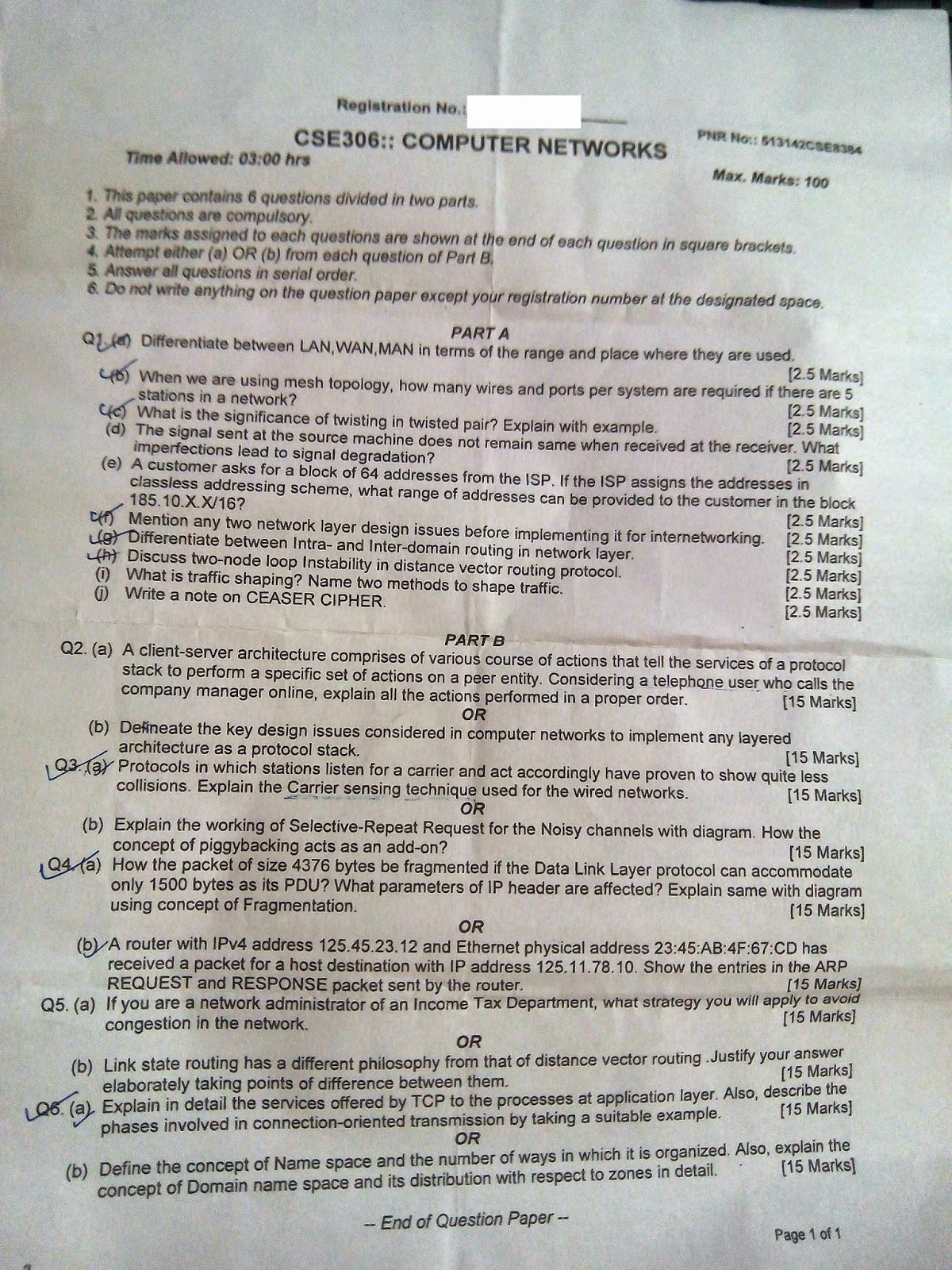CSE306 COMPUTER NETWORKS
Course:CSE306::COMPUTER
NETWORKS
Time Allowed:
03:00 hrs Max. Marks: 100
1.
This paper contains 6 questions divided in two
parts.
2.
All questions are compulsory.
3.
The marks assigned to each questions are shown
at the end of the question in square brackets.
4.
Attempt either (a) OR (b) from each question of
Part B.
5.
Answer all the questions in serial order.
6.
Do not write anything on the question paper
except your registration number at the designated space.
PART A
Q1.
a)
Differentiate between LAN, WAN, MAN in terms of
the range and place where they are used.
b)
When we are using mesh topology, how many wires
and ports per system are required if there are 5 stations in a network?
c)
What is the significance of twisting in twisted
pair? Explain with example.
d)
The signal sent at the source machine does not
remain same when received at the receiver. What imperfections lead to signal
degradation?
e)
A customer asks for a block of 64 addresses from
ISP. If the ISP assigns the addresses in classless addressing scheme, what
range of addresses can be provided to the customer in the block classless
addressing scheme, what range of address can be provided to the customer in the
block 185.10.X.X/16?
f)
Mention ant two network layer design issues
before implementing it for internetworking.
g)
Differentiate between intra- and inter-domain
routing in network layer.
h)
Discuss two-node loop Instability in distance
vector routing protocol.
i)
What is traffic shaping? Name two methods to
shape traffic.
j)
Write a note on CEASER CIPHER.
PART B
Q2.
a)
A client-server architecture comprises of
various courses of actions that tell the services of a protocol stack to perform
a specific set of actions on a peer entity. Considering a telephone user who
calls the company manager online, explain all the actions performed in a proper
order.
OR
b)
Delineate the key design issues considered in
computer networks to implement any layered architecture as a protocol stack.
Q3.
a)
Protocols in which stations listen for a carrier
and act accordingly have proven to show quite less collisions. Explain the
Carrier sensing technique used for the wired networks.
OR
b)
Explain the working of Selective-Repeat Request
for the Noisy channels with diagram. How the concept of piggybacking acts as an
add-on?
Q4
a)
How the packet of size 4376 bytes be fragmented
if the Data Link Layer protocol can accommodate only 1500 bytes as its PDU?
What parameters of IP header are affected? Explain same with diagram using
concept of Fragmentation.
OR
b)
A router with IPV4 address 125.45.23.12 and
Ethernet physical address 23:45:AB:4F:67:CD has received a packet for a host
destination with IP address 125.11.78.10. Show the entries in the ARP REQUEST
and RESPONSE packet sent by the router.
Q5.
a)
If you are a network administrator of an income
tax department, what strategy you will apply to avoid congestion in the
network.
OR
b)
Link state routing has a different philosophy
from that of distance vector routing. Justify your answer elaborately taking
points of difference between them.
Q6.
a)
Explain in detail the services offered by TCP to
the processes at application layer. Also, describe the phases involved in
connection-oriented transmission by taking a suitable example.
OR
b)
Define the concept of Name space and the number
of ways in which it is organized. Also, explain the concept of Domain name
space and its distribution with respect to zones in detail.
--End of Question
Paper--
.png)
















0 comments: